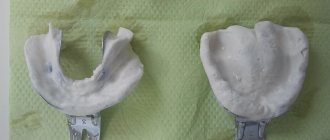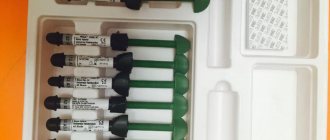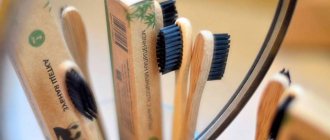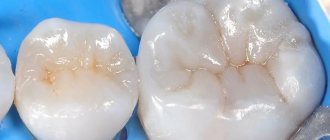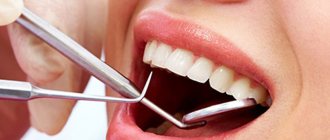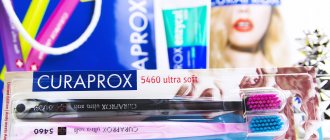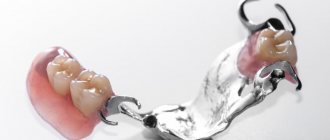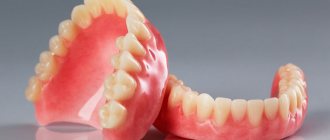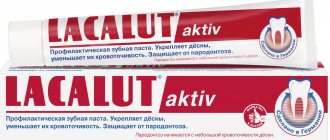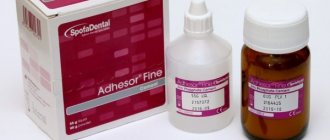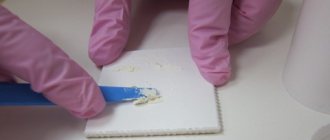The purpose of a diagnostic cast is to create a model of the dentition. Not all the necessary information can be obtained by examining the oral cavity. The model will allow the dentist to understand and take into account the individual characteristics of the position of the teeth, dental arches, possible anomalies (for example, diastema - a gap between the teeth, etc.), tissue relief and much more.
Once the impression is received, it is sent to the laboratory, filled with plaster and a diagnostic three-dimensional model is obtained, usually of both jaws. Both jaw models are installed in a special device (articulator), which simulates the movements of the jaws during chewing.
The diagnostic model is useful when communicating between a doctor and a patient, because you can clearly demonstrate existing problems and jointly discuss a way out of the situation. Using the model, you can explain to the patient the validity of a particular decision made by a doctor. You cannot do without a diagnostic model when correcting your bite or making prosthetics.
Diagnostic dental cast: materials and varieties
Materials
To obtain a diagnostic impression of teeth, medical plaster and more modern plastic materials (thermoplastic and elastic masses) are used, which are able to acquire the shape of the dentition and maintain it.
All materials from which the impressions are made do not cause allergies. They are divided into several types:
- Hard (gypsum, dentol). They reproduce the texture of fabrics well, are easy to use, but are excessively rigid. Because of this, imprints of areas of the tooth located closer to the gum are not always successful.
- Elastic (silicone, alginate, etc.). To enhance the strength of the impression mass, special fillers are added to it. When heated, such an impression mass becomes softer and recreates the contours of tissues well. Disadvantage: elastic impressions are not suitable for long-term storage, unlike hard ones. For example, silicone impressions shrink within 3 hours after the impression. The model must be manufactured strictly within this period of time.
- Thermoplastic (gutta-percha, Kerr mass). The material becomes plastic when heated and hardens after cooling. Advantages of this type of casts:
- good separation from plaster during model making;
- Possibility of repeated administration into the oral cavity.
Types of diagnostic casts
Compression diagnostic casts . Made for the lower jaw. Purpose - to determine the distribution of load during chewing for the future prosthesis. Requires materials of high viscosity.
Unloading . They are used in the preparation of prosthetics for people whose activities are related to oral speech. When chewing, the load will be distributed unevenly.
Combined . With their help, dentures are made that evenly distribute the load both during eating and when talking.
Medical Internet conferences
Comparative characteristics of modern alginate and C - silicone impression masses
Belyankin I.A., Afanasyeva M.M., Aslanyan M.A.
Heads: assistant of the department Nelovko T.V., head of the department Eremin O.V.
FSBEI HE "Saratov State Medical University named after. V.I. Razumovsky" of the Ministry of Health of Russia
Department of Propaedeutics of Dental Diseases
Modern dentists are faced with choosing the most appropriate impression mass.
Purpose : to explore and compare the properties and purposes of modern alginate and C-silicone impression masses.
Materials and methods : 1) Alginates are a fine multicomponent powder that must be thoroughly mixed with water, rubbing against the walls of the rubber container for 40 seconds, hardens in 2-3 minutes. (Ypeen).
2) C - silicones: the base is a container with a mass and a hardener in a tube; a large tube with a correction mass and a second one with a catalyst. The base is intensively mixed with your fingertips until homogeneity is achieved for 30 seconds, the corrective is mixed on a notepad 1:1; hardens - 2.5-5 minutes. (Speedex).
Results: The alginate mass has a viscous consistency. Accurately reproduces the microrelief of oral tissues, but is inferior to C-silicones.
Advantages of alginate masses: Low cost; ease of use; acceptable accuracy of cast relief for removable dentures and temporary crowns.
Cons: Insufficient accuracy for solid-cast and metal-ceramic structures; strong and rapid shrinkage (after 15-20 minutes 1.5%); the need for immediate casting of the model; poor adhesion to the spoon.
Pros of C - silicone masses: Reasonable cost; sufficient accuracy for solid-cast and metal-ceramic structures, silicone keys; low shrinkage (after 1-3 days 0.1-0.5%); elasticity and strength; admissibility of disinfection; Possibility of casting models in 2 days.
Cons: Difficulty in accurately dosing the catalyst; single use of the impression; hygroscopicity; low hydrophilicity; insufficient adhesion to the spoon; the possibility of allergies; the need for manual mixing.
Conclusion: Alginate and C-silicone impression masses are widely used in modern orthopedic and therapeutic dentistry. Based on the analysis of the parameters, alginate masses are more suitable for the auxiliary jaw, and silicone ones for the working jaw. The properties of alginates are inferior to C-silicone materials.
Taking a diagnostic impression
The oral cavity must be prepared
Having agreed with the patient on the type of prosthesis, selecting the materials for the impression and the necessary tools, the prosthetist begins the procedure of taking the impression. It begins with an examination of the oral cavity and determining whether individual teeth require extraction or treatment.
If there are bone growths (exostoses) in the place of the former lateral chewing teeth, the doctor will have to remove them. The oral cavity is thoroughly dried with cotton swabs or a special dental gun. Now it’s time to start selecting a spoon, an instrument with which the impression mass is introduced into the oral cavity.
Spoon selection
Selecting a tray is an important step as there are several types of impression trays. They differ:
- Size . For jaws and dentition of different lengths, sizes and shapes, teeth of different heights, a suitable spoon is required. A standard set of spoons is not suitable in all cases. Sometimes you have to make a spoon individually.
- Material. Spoons come in metal and plastic, with different hardnesses.
- By appointment . A special tray is used to take an impression of the lower or upper jaw.
- A type of cast . Separate trays are provided for compression and decompression (without pressure on the gum) impressions.
Preparing the impression material, applying the material to the tray and taking the impression
Having selected the correct spoon, the prosthetist begins mixing the impression mass.
The prepared mass is placed on a spoon, then, using a spoon, into the oral cavity.
The spoon is positioned and pressed first in the area of the chewing teeth, then in the frontal teeth.
Without waiting for hardening, the prosthetist removes the spoon from the mouth very carefully so as not to damage the impression.
Two-stage and one-stage method of taking an impression
With the two-stage method, the impression is made in two steps. First, the main impression material is introduced, the first impression is made, and dried. Then a corrective composition is applied to it and the impression is made again. The one-step method involves simultaneous application of the main mass and the corrective composition to the spoon. The finished impression remains to be washed, disinfected and sent to the denture laboratory for the production of a diagnostic model.
Impression materials
The impression mass must satisfy the following requirements: give an accurate impression of the prosthetic bed; be harmless and not have an unpleasant odor or taste; easy to enter and remove from the oral cavity; do not become deformed when removed from the oral cavity; do not dissolve under the influence of saliva; soften at a temperature that does not cause burns to the oral mucosa; harden for 2-5 minutes; do not connect to the model plaster and are easily separated from it; be stored at room temperature without losing its properties.
Crystallizing (hard) impression masses . Solid impression masses include gypsum, zinc-eugenol masses, Dentol-M, Dentol-S. Currently, gypsum is practically not used in dental practice for making impressions due to its non-plasticity, traumatic nature, fragility, and poor biocompatibility with oral tissues. Zinc-oxyeugenol impression materials contain zinc oxide, eugenol, filler, structuring accelerator, rosin, balsam, plasticizer, and dyes. Impression materials of this group are produced in the form of two separately stored pastes, one of which contains eugenol (or gualcol), the other – zinc oxide. Structuring occurs when zinc oxide reacts with eugenol (when two pastes are mixed). This material gives minimal shrinkage, is durable, and highly plastic. It is mainly used for taking impressions of toothless jaws. Thermoplastic impression compounds . A feature of thermoplastic impression compounds is that they soften and harden only under the influence of temperature. They soften when heated and harden when cooled. Thermoplastic masses are multicomponent systems based on natural or synthetic resins, filler, modifying additives, plasticizer and dyes. This group primarily includes wax, as well as gutta-percha. Thermal masses should soften at a temperature that does not cause burns to the tissues of the oral cavity, and harden at a temperature slightly higher than the temperature of the oral cavity. These include Weinstein masses, Kerr masses, Orthocor, Stomaplast, Dentafol, etc.
Elastic impression materials . Elastic impression compounds include a large group of different substances, the characteristic feature of which is the ability to acquire elastic, elastic properties as a result of structuring. Based on agar-agar (a product obtained from some agarophyte seaweed), 2 groups of elastic materials have been developed: hydrocolloid and alginate.
Alginate impression masses contain a main component – sodium alginate (sodium salt of alginate acid). These are: Algelast-66 (paste powder), Stomalgin-66 (powder), Novalgin (powder), Orthoprint, Hydragum, Dupaflex, Tricoloralgin, Palgaflex, Propalgin, etc. The advantages of alginate masses include: high elasticity and hardness, good reproduction relief of hard and soft tissues of the oral cavity, ease of use, absence of unpleasant odor, good tolerance by patients. Working models from these masses are obtained in the manufacture of complete and partial dentures. However, alginate masses are not used for cellite structures due to the unsatisfactory accuracy of displaying the cervical and subgingival areas, as well as the high shrinkage of these materials. In addition, it is advisable to cast models using alginate impressions within 10-15 minutes (due to high shrinkage), which is not always convenient.
Silicone (rubber-like) impression materials . Currently, in the dental practice of dental prosthetics, silicone masses based on organosilicon polymers - silicone rubbers - are increasingly used. They are produced as a set in the form of pastes and liquid catalysts, when mixed, vulcanization occurs within a few minutes and an elastic product is formed that does not lose its properties for a long time. Based on the type of vulcanization, silicone masses are divided into C- and A-silicones. C-silicones harden under the influence of a polycondensation reaction. Materials of this class are subject to fairly strong shrinkage (less, however, than that of alginate masses) due to the formation of by-products - alcohol and water. Models based on impressions from C-silicone are cast in 1-2 hours. A-silicones cure through a polymerization reaction that produces virtually no byproducts. Models based on them can be cast without loss of quality within a period of up to a month, but preferably within a week. The disadvantages of this type of materials include their lack of good adhesion to impression trays. One of the most commonly used silicone materials is Sielast-69. Its vulcanization (hardening) time in the oral cavity is 4-5 minutes. The materials Sielast-0.3 and Sielast-0.5 are intended for taking double impressions, for which they include the main and corrective pastes and a liquid catalyst. Silicone pastes Exaflex (Japan), Coltex + Coltoflex (Switzerland), Dentaflex (Czech Republic), Tsafo-Tevezil, DL-Knet, Panasil, Formasil II, Alfasil, Gammasil, Deguflex (Germany), etc. are widely used.
Our clinics use only advanced methods of treating and diagnosing oral problems. We are waiting for you!
